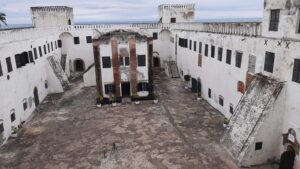Not-Touring through the Darkness of Elmina Castle
By Albert Olatunde Oloruntoba
 Elmina Castle, Cape Coast, Ghana
Elmina Castle, Cape Coast, Ghana
History can really be unpleasant, and memories could be traumatic, but humans need constant reminder of history in order to progress. It doesn’t seem like there will ever be a time when the colonial history of Africa will cease to influence contemporary discourses, at least not when you have had the kind of trip that I recently had in Ghana. I mean, I wasn’t born when trans-Atlantic slave trade happened. I am not even sure if my parents were, but my recent trip to Cape Coast, Ghana just two weeks ago, seemed to bring back memories of events I never experienced. As part of scholars working on African Urbanities, a project principally investigated by Prof James Ogude, Director of CAS, University of Pretoria, our hosts, Institute of African Studies, at the University of Ghana took us to Cape Coast, a World Heritage Site where we went to the Elmina Castle. What I saw blew my mind to say the least. Did it also stair up some emotions in me? I guess!
According to Bruce, the director of the castle and our tour guide for that day, through Elmina Castle, millions of slaves were captured, tortured, and shipped across the Atlantic Ocean between a period of 1400 and 1900. That was the closest I had been to the Atlantic Ocean, and I bet I wouldn’t have been able to look at it. What our ancestors went through is unimaginable, especially when you see what at this castle and other castles on the continent referred to as “point of no return”. The building which according to Bruce was built in 1482 still stands in good shape today with cannons in front of it facing the sea, and various defensive mechanisms that were put in place to ward off and fight off potential European intruders.
One of the most fascinating things to behold for me was the presence of two churches the castle. Missionaries lived in the castle with the slave traders, dinned with them, and worshipped with them in these churches. How these paradoxical phenomena worked together, I would not understand. I mean, these were churches with reverends, preaching about God yet are resident in the same building with slave traders and slave captives who were treated inhumanely. This ‘God’ of theirs was wonderful, I must say. Chinua Achebe’s Things Fall Apart reads a bit clearer to me now.
Why am I even writing this now? What do I stand to gain? I guess I needed to just put my experience on record as the images I saw keep playing in my head. Do I think this over 500 years old building, Elmina castle is an interesting site? I seriously think it represents a painful scar of the brutality of humanity on humanity. I mean, you could truly feel the inhumane conditions that the slaves went through as you go through the Castle. What memories does the building bring to the Cape Coast residents and Africans altogether? I bet I will never know where to place it. But as we laud the courage of these men and women whose bloods have irrigated western fields that have translated to some of the economic heights that have today been attained, we will never forget where we have come from.



Thank you for the auspicious writeup. It in fact was a leisure account it.
Look complicated to more delivered agreeable from you!
However, how could we be in contact?
Thank you for your feedback. Please contact us by chatting through the green chat box at the bottom of the website.